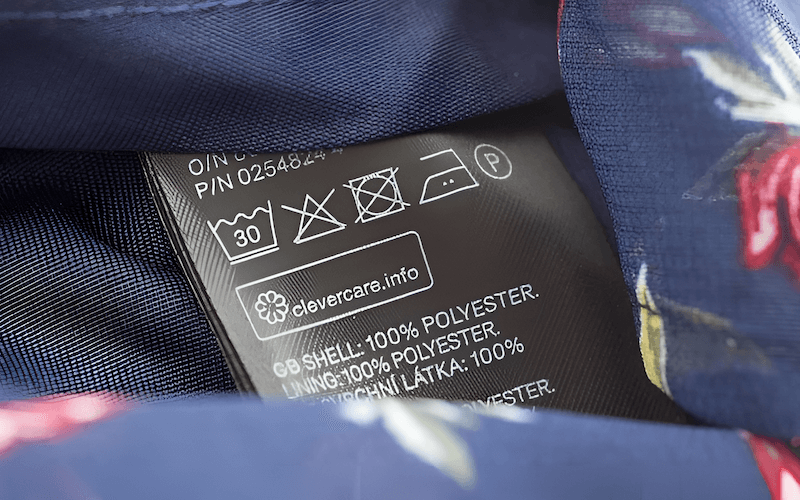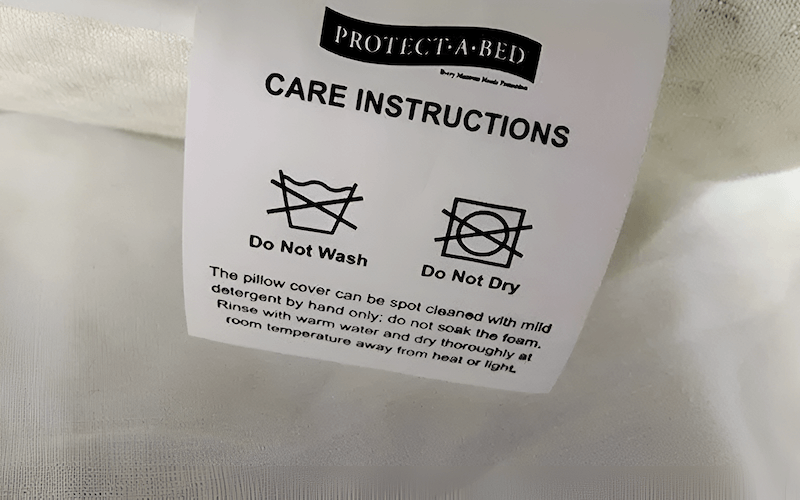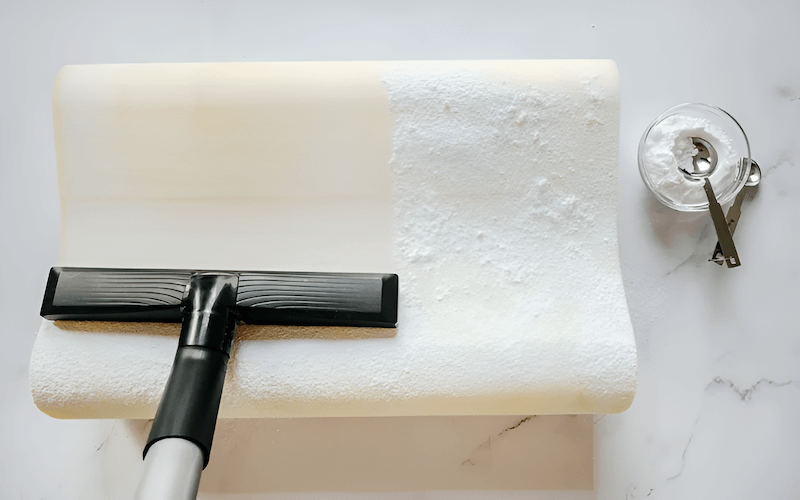Pillow Care Labels: Symbols, Materials and Washing Guide
Proper care is essential for maintaining the hygiene, comfort, and longevity of your pillows, which are used daily. Understanding the care label is the first step. This comprehensive guide to pillow care labels will empower you to confidently care for any pillow, whether you’re looking to refresh your bedding, maintain your handmade creations, or improve product durability, protecting your investment and avoiding potential damage.
Decoding care label symbols and instructions can be confusing, leading to improper cleaning and a shortened lifespan for your pillows. Our guide provides clear explanations of common symbols, washing methods for various materials like memory foam, latex, down, and synthetic fibers, and crucial tips for preserving these diverse fillings. We’ve got you covered from “Drip Dry” to “Do Not Bleach.”
For businesses, including bedding retailers and handmade pillow creators, understanding care labels isn’t just about maintenance—it’s also about compliance. We help you provide the accurate labeling needed to meet industry standard. Discover how to make the most of your pillows and ensure customer satisfaction.
1. Decoding pillow care label instructions: A comprehensive guide
1.1 Why pillow care label matter
Pillow care labels are more than just small tags; they’re your guide to maintaining your investment. Following the washing instructions on these textile labels is critical for preserving the quality and extending the longevity of your pillows. Proper fabric care, as detailed on the label, prevents damage and ensures lasting comfort.
Adhering to care label instructions is also crucial for hygiene. Clean pillows mean fewer allergens, providing a healthier sleep environment. For businesses, compliance with FTC regulations regarding care labeling is a legal requirement. Packlove provides solutions to help you stay informed and improve product durability.
1.2 Common terms and instructions on pillow care labels
Understanding the specific terms on your pillow’s care tag is key to proper maintenance. Here’s a guide to some common washing symbols and drying instructions, ensuring you follow the best product care practices:
- Block to Dry: Reshape the item to its original form and size while drying, either by hanging or laying it flat.
- Cold Water: Wash in water up to 30 degrees Celsius (85 degrees Fahrenheit) to maintain color and fabric.
- Delicate Cycle/Gentle Cycle: Use a slow agitation setting or hand wash for items with delicate embroidery.
- Do Not Bleach: Avoid using any type of bleach to prevent weakening fibers. Always opt for gentle, bleach-free detergents.
- Dry Clean Only: Take the item to a professional dry cleaner.
- Drip Dry: Hang the item and allow it to air dry naturally.
- Machine Wash: Safe to wash in a machine, following temperature and cycle instructions.
- Steam Iron: Safe to use a steam iron.
- Tumble Dry: Safe to dry in a machine, following temperature settings.
- Wash Separately: Launder alone or with similar colors to prevent bleeding.
2. Understanding pillow care label symbols
2.1 The universal language of laundry symbols
International care labeling symbols, defined by ISO 3758, provide a standardized system for conveying care instructions. These laundry symbols transcend language barriers, offering concise washing symbols and care symbols that are universally understood. This standardization simplifies garment care for consumers worldwide and ensures consistent instructions across different brands and regions.

2.2 Deciphering washing, drying, ironing, and bleaching symbols
| Category | Symbol | Meaning |
|---|---|---|
| Washing | A tub with water | Machine Washable |
| Washing | A tub with a hand | Hand Wash Only |
| Washing | A tub with a number (e.g., 30°C) | Maximum Wash Temperature (e.g., 30°C/85°F) |
| Washing | A tub with a line underneath | Permanent Press Cycle |
| Washing | A tub with two lines underneath | Delicate/Gentle Cycle |
| Washing | A crossed-out tub | Do Not Wash |
| Drying | A square | Tumble Dry Allowed |
| Drying | A circle inside a square | Tumble Dry Normal |
| Drying | A circle inside a square with one dot | Tumble Dry Low Heat |
| Drying | A circle inside a square with two dots | Tumble Dry Medium Heat |
| Drying | A circle inside a square with three dots | Tumble Dry High Heat |
| Drying | A filled-in circle inside a square | Tumble Dry No Heat/Air |
| Drying | A crossed-out square with a circle inside | Do Not Tumble Dry |
| Drying | A square with three vertical lines inside | Line Dry/Hang Dry |
| Drying | A square with a horizontal line inside | Dry Flat |
| Drying | A square with two diagonal lines in the corner | Dry in Shade |
| Ironing | An iron | Ironing Allowed |
| Ironing | An iron with one dot | Iron Low Heat |
| Ironing | An iron with two dots | Iron Medium Heat |
| Ironing | An iron with three dots | Iron High Heat |
| Ironing | A crossed-out iron | Do Not Iron |
| Ironing | An iron with steam lines below | Steam Ironing Allowed |
| Ironing | A crossed-out iron with steam lines below | Do Not Steam Iron |
| Bleaching | A triangle | Bleaching Allowed |
| Bleaching | A triangle with two diagonal lines inside | Use Non-Chlorine Bleach Only |
| Bleaching | A crossed-out triangle | Do Not Bleach |
It should include washing symbols, drying instructions, ironing symbols, and bleaching instructions. For example, symbols will dictate things like “Do Not Bleach” and “Tumble Dry Low,” or”Machine Wash Cold.”
3. Additional warnings and instructions on pillow care labels
Besides the standard symbols, pillow care labels often include additional instructions written out. Understanding these special care instructions is crucial for proper fabric care and pillow maintenance. Here’s a guide to some common phrases:
- Damp Wipe Clean: Clean the surface with a damp cloth or sponge. Do not machine wash or dry.
- Do Not Iron: Do not iron or apply heat.
- Do Not Spin: Remove the item before the spin cycle.
- Do Not Use Chlorine Bleach: Only oxygen-based bleaches are safe.
- Do Not Wring: Hang dry, drip dry, or flat dry only.
- Dry Flat: Lay the item horizontally on a breathable surface.
- Hand Wash: Launder by hand in lukewarm water.
- Home Launder Only: Wash, bleach, dry, and press normally, but avoid dry cleaning chemicals.
- Hot Wash: Use hot water in the washing machine.
- Iron Cool: Use the lowest iron setting.
- Iron Damp: Dampen the item before ironing.
- Iron Hot: Use the highest iron setting.
- Iron Wrong Side Only: Turn item inside out to iron.
- Line Dry: Hang damp to dry, and do not put it automatic dryer.
- Machine Wash: Use any method to wash, bleach, dry, and press.
- No Heat: Choose a “no heat” setting.
- Permanent Press: Utilize the appropriate machine setting.
- Professionally Dry Clean Only: Use professional dry cleaning services only.
- Remove Promptly: If there isn’t cool-down cycle, take out item immediately.
- Steam Iron: Can press with steam.
- Tumble Dry: Use tumble dryer.
- Warm Iron: Use a medium iron setting.
- Warm Wash / Rinse: Use warm water.
- Wash Inside Out: Turn inside out before washing.

4. Cleaning different types of pillows: A material-specific guide
4.1 Memory foam pillow care
Memory foam pillows require special care. Do not machine wash memory foam, as it damages the material’s structure. Instead, spot clean with a mild detergent and a damp cloth. Rinse by blotting with a clean, damp cloth. Vacuum regularly to remove dust. Always air dry, avoiding direct heat or sunlight.
4.2 Latex pillow care
Similar to memory foam, latex pillows (both natural latex and synthetic latex) generally should not be machine washed. Spot clean with mild detergent and a damp cloth. Rinse with a clean, damp cloth. Air dry in a cool, well-ventilated area, avoiding direct sunlight, which can damage the material, especially natural latex.

4.3 Down and feather pillow care
Always check the care label first. If machine washable, use a front-loading washer on a gentle cycle with mild detergent. Thorough drying is critical to prevent mildew. Use low heat and dryer balls to fluff the feathers. Air drying is also an option, but ensure complete dryness. Down and feather pillows usually can use this way to wash.
4.4 Synthetic/Hollow fiber pillow care
Synthetic pillow and hollow fiber pillow care are typically the easiest. Most are machine washable; check the label. Use a gentle cycle with warm water and mild detergent. Tumble dry low, or air dry. These pillows are generally more resilient to machine washing than other types.
5. General tips for maintaining all types of pillows
5.1 Extending pillow lifespan: Best practices
Using pillow protectors is a highly effective way to reduce the frequency of washing and extend pillow lifespan. Regularly airing pillows out helps reduce moisture and odors. Fluffing pillows regularly maintains their shape and support. Rotating pillows can also promote even wear.
5.2 Importance of always checking the care label
Prioritize checking the care label and always adhering to the manufacturer’s instructions provided. This is the single most important step in ensuring proper pillow care and avoiding damage. Different manufacturers may use slightly different materials or construction methods.
6. FAQs about pillow care labels
6.1 Can I use fabric softener on my pillows?
Generally, it’s best to avoid using fabric softener on pillows. Fabric softener can reduce the absorbency of the pillow’s filling and cover, making it less effective at wicking away moisture. It can also leave behind a residue that can build up over time, potentially affecting the pillow’s feel and breathability. Stick to mild detergent for the best results.
6.2 How often should I wash my pillows?
Pillow protectors should be washed more frequently, typically every one to two months, or more often if needed. The pillows themselves should be washed every three to six months. However, the ideal frequency depends on individual factors like usage, allergies, and personal preference. If you sweat a lot or have allergies, more frequent washing may be necessary.
6.3 What does “dry clean only” mean for a pillow?
“Dry clean only” means the pillow should be cleaned by a professional dry cleaning service. It indicates that the materials or construction of the pillow are not suitable for washing with water or conventional home laundering methods.
Attempting to wash a “dry clean only” pillow at home can damage the filling, fabric, or overall structure of the pillow.
6.4 My pillow care label says “tumble dry low,” but my dryer doesn’t have a low setting. What should I do?
If your dryer doesn’t have a dedicated “low” heat setting, use the lowest available setting. Alternatively, air-drying is always a safe option, especially for delicate fillings like down or memory foam. Make sure the air dry at a suitable place.
Air drying may take longer, but it eliminates the risk of heat damage. Ensure the pillow is completely dry before using it to prevent mildew growth.
7. Packlove – Providing service for custom pillow care labels
Elevate your brand and ensure customer satisfaction with Packlove’s custom pillow care label services. We offer high-quality materials, including woven labels and printed labels, ensuring your fabric labels are as durable as they are informative. Our printing is long-lasting, resisting fading and wear even after repeated washings.
We understand the importance of compliance. Our labels meet industry standards, giving you peace of mind. We provide fully customizable designs to match your brand aesthetic, along with fast turnaround times. Contact us today! Our team has extensive experience crafting custom care labels.
Read more:
Understanding pillow care labels is essential for preserving the quality, hygiene, and lifespan of your pillows. This includes familiarizing yourself with the various symbols and instructions, and adhering to best practices for cleaning different pillow types, from memory foam to down. Proper care is an investment that pays off in long-term comfort and value.
Remember to always check the care label for specific instructions from the manufacturer. For businesses, providing clear and compliant care labels is not only a legal requirement but also a crucial aspect of customer satisfaction. Partner with Packlove for all your custom pillow care label needs. Get your Value Booster Kit, enhancing your brand’s value and recognition.






















